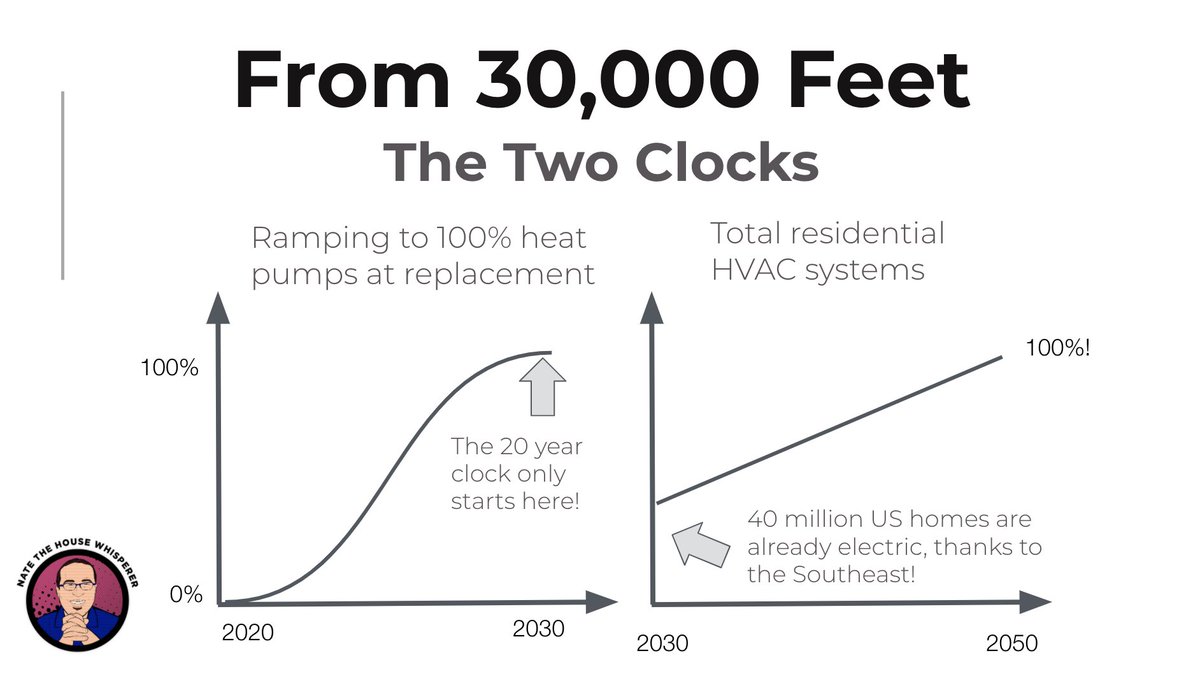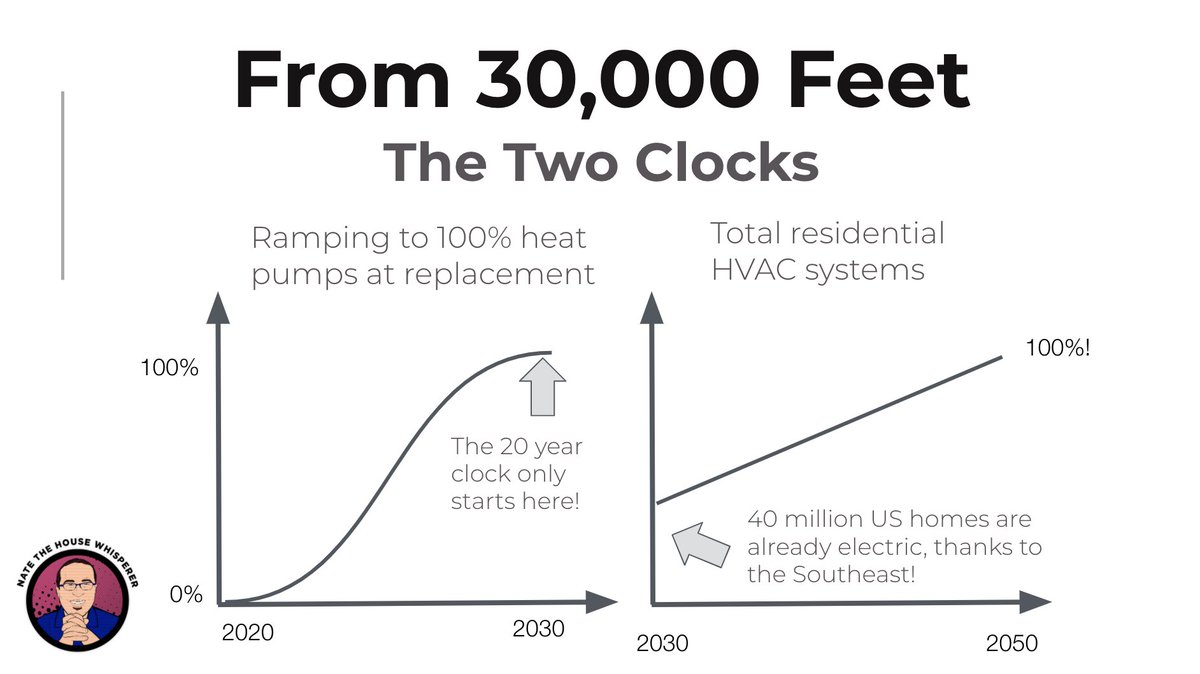A Heat Pump Policy Thread:
What if we paid resi HVAC manufacturers ~$400 per AC they manufacture if they make all of their production heat pumps?
Currently US OEMs make ~5M ACs and ~3M heat pumps. What if they were all heat pumps?
This might only cost ~$10 billion over 4 yrs
What if we paid resi HVAC manufacturers ~$400 per AC they manufacture if they make all of their production heat pumps?
Currently US OEMs make ~5M ACs and ~3M heat pumps. What if they were all heat pumps?
This might only cost ~$10 billion over 4 yrs
We think of residential electrification in "Two Clocks".
The first is getting to where 100% of installs involve a heat pump. Doing that by 2030 is REALLY HARD.
The second is running through all inventory, which will take ~20 years.
The first is getting to where 100% of installs involve a heat pump. Doing that by 2030 is REALLY HARD.
The second is running through all inventory, which will take ~20 years.

Every 6 seconds a new piece of residential HVAC starts up in the US.
That opportunity is lost until 2035-2040.
The faster we can move to 100% heat pump installs, the better.
That opportunity is lost until 2035-2040.
The faster we can move to 100% heat pump installs, the better.
BUT we have to avoid the "screw you I won't do what you tell me" instinct that is STRONG in us humans.
We could largely avoid if there were nothing but heat pumps available at supply houses and manufacturers were made whole for making them.
We could largely avoid if there were nothing but heat pumps available at supply houses and manufacturers were made whole for making them.
So back to paying HVAC manufacturers to make only heat pumps.
An AC is basically a one way heat pump. It can cool but not heat.
A heat pump in US parlance is two-way, it can cool AND heat.
Most ACs have a heat pump version. We already have the production in place.
An AC is basically a one way heat pump. It can cool but not heat.
A heat pump in US parlance is two-way, it can cool AND heat.
Most ACs have a heat pump version. We already have the production in place.
The difference is basically a few valves or ~$100-300 in parts.
So start by paying manufacturers $400 each for every heat pump they make (yes, that includes current ones), but only once 100% of production is heat pumps.
The second year, drop it to $300. Then $200, $100, and 0.
The second year, drop it to $300. Then $200, $100, and 0.
At that point the cost savings to manufacturers and the supply chain of having to make and stock fewer parts will likely make it a wash cost wise.
And we will have stopped that first clock in a few years, not 10.
And we will have stopped that first clock in a few years, not 10.

$400 x 8 million units is $3.2 billion for the first year. The other 3 years add up to $4.8B. So ~$8B total.
Chump change at the federal level, especially when it can move such a large part of energy use as residential fossil gas.
Chump change at the federal level, especially when it can move such a large part of energy use as residential fossil gas.
There are two big caveats here though.
First, many systems will remain hybrids (furnace + heat pumps).
That's ok. The next time those homeowners are much more likely to be open to a heat pump only system.
Hybrids use 50-90% less gas in our experience, so it's still a big win.
First, many systems will remain hybrids (furnace + heat pumps).
That's ok. The next time those homeowners are much more likely to be open to a heat pump only system.
Hybrids use 50-90% less gas in our experience, so it's still a big win.
Second caveat: many won't be hooked up as heat pumps, only as ACs.
Don't let this bother you! The capability will be there, all that is required is a different thermostat and maybe a new thermostat wire.
Figure that out later.
Don't let this bother you! The capability will be there, all that is required is a different thermostat and maybe a new thermostat wire.
Figure that out later.
All of this happens upstream of the kitchen table transaction.
Anything that makes it harder for contractors or homeowners will slow down adoption.
Be VICIOUS avoiding anything that hurts that transaction.
Anything that makes it harder for contractors or homeowners will slow down adoption.
Be VICIOUS avoiding anything that hurts that transaction.

So there you go:
A way to get to 100% residential heat pump penetration in just a few years, instead of 10, for about $10 billion over 4 years.
A way to get to 100% residential heat pump penetration in just a few years, instead of 10, for about $10 billion over 4 years.
But wait there's more!
This won't necessarily lead to variable speed inverter heat pumps that deliver excellent experiences.
That's where state and local help might come in.
Or, cough, cough, the HVAC 2.0 program that helps consumers see the value in higher end HVAC.
<fin>
This won't necessarily lead to variable speed inverter heat pumps that deliver excellent experiences.
That's where state and local help might come in.
Or, cough, cough, the HVAC 2.0 program that helps consumers see the value in higher end HVAC.
<fin>
@John_Maiorano Phased mandate is possible, but beware the "screw you I won't do what you tell me" effect that will make it harder for everyone.
Add grease, not friction.
Add grease, not friction.
PS I chafe at making big companies the primary benefactor here.
Also, if you like the thread, retweet it. 🤓
Also, if you like the thread, retweet it. 🤓
@DinosGonatas @brad_bradshaw @SparkplugPower Brad, that's just what we're trying to jump start by suggesting this, but we're working on it with the HVAC 2.0 program that naturally bends towards electrification. HVAC 2.0 will be slower, but my personal BHAG is to move to 100% of new resi systems having a heat pump by 2030.
@CobyRudolph $400 would MORE than cover the cost in most cases I think, and they'd still get it for the 3M/year they are already making, so I would suspect they would jump on board.
I suspect the costs would drop enough over time to be a wash.
@abrunello maybe bounce this off Rheem?
I suspect the costs would drop enough over time to be a wash.
@abrunello maybe bounce this off Rheem?
@brendanpierpont What this doesn't do well is push towards inverter heat pumps which are needed for a) good experiences and b) cold climates.
That will still need to be done elsewhere. If heat pumps are poorly applied (and they often are), consumer experiences suck.
That will still need to be done elsewhere. If heat pumps are poorly applied (and they often are), consumer experiences suck.
@threadreaderapp unroll please
@W_J_Henry @goldenmatt @SaroyaArjun You can't just install a bigger heat pump though, they need more airflow than furnaces. Most duct systems can only handle 2-3 tons of airflow. Your house may need 4-5 tons of heat (48,000-60,000 btus/hour).
Too big of a unit and it'll die very early from high static pressure.
Too big of a unit and it'll die very early from high static pressure.
@W_J_Henry @goldenmatt @SaroyaArjun I'm hustling to get an Electrify Everything course done, that is one part of it.
To measure static pressure you need a $500 manometer minimum, so it's best done by a contractor that has the tool.
To measure static pressure you need a $500 manometer minimum, so it's best done by a contractor that has the tool.
A few peer review updates as I run this by my contractor friends:
1. Lower heat pump prices need to be passed on into the market.
2. Replacement parts for ACs will need to remain available along with some replacement units. Not a huge lift imho.
1. Lower heat pump prices need to be passed on into the market.
2. Replacement parts for ACs will need to remain available along with some replacement units. Not a huge lift imho.
3. Hybrids in mild climates may NEVER run the furnace, like at @stephenrardon's house. It hasn't run since the system was fired up 7 years ago. So don't fight hybrids too hard, let everyone keep their safety blanket for now. 

Number one does concern me, and I'm not used to writing rules. Any thoughts are appreciated.
@W_J_Henry @JohnSemmelhack @Negawatt_Nate Conversely, if there is real value in buying a better heat pump, my resistance drops.
This is just what we do in HVAC 2.0 - show the value of better equipment which is naturally better for the grid.
This is just what we do in HVAC 2.0 - show the value of better equipment which is naturally better for the grid.
This thread is now a policy paper thanks to @CLASPappliances @spantano and @GardMurray !
Take a read: bit.ly/3pg7tMK
Take a read: bit.ly/3pg7tMK
It also went into the HEATR Act from @SenAmyKlobuchar last year.
A new, cleaner version may be in the works…
Lots of resources on last year’s bill here including some short summaries. bit.ly/HEATRendorseme…
A new, cleaner version may be in the works…
Lots of resources on last year’s bill here including some short summaries. bit.ly/HEATRendorseme…
Oh, and Vancouver implemented the idea, they require that all new ACs be heat pumps. @CAHiggins is there a good article to point to, and any feedback on the program so far?
• • •
Missing some Tweet in this thread? You can try to
force a refresh








